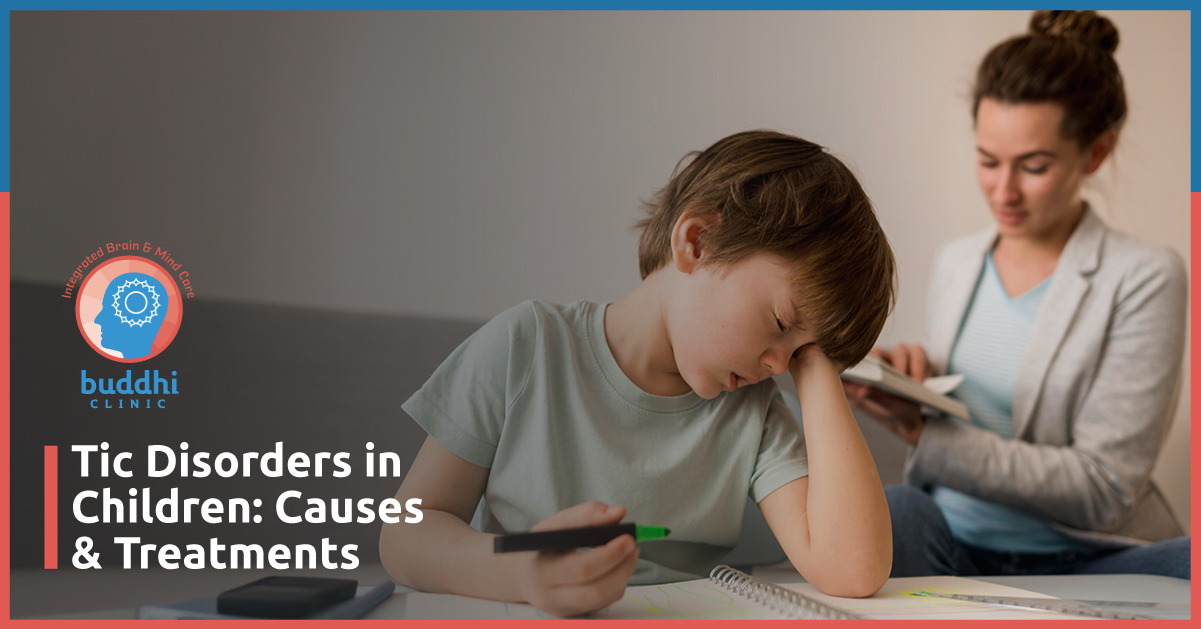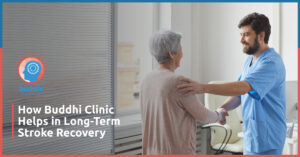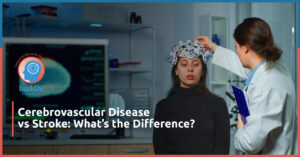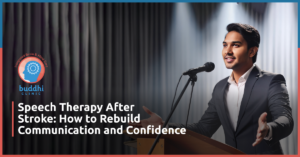Introduction
Tic disorders are neurological disorders that result in abrupt, repetitive, and involuntary movement or sound. Although most children have mild tics that eventually fade away, others develop persistent tic disorders that disrupt daily living. It is important for parents to know the causes, signs, and treatment of tic disorders in children in order to provide the most appropriate care to their child.
This blog discusses tic disorders, what causes them, and specialized treatments provided at Buddhi Clinic.
What Are Tic Disorders?
Tic disorders are disorders that result in involuntary movements or sounds. The tics may be simple (e.g., blinking or clearing the throat) or complex (e.g., repeating certain words or phrases or movements that are coordinated).
Types of Tic Disorders
1. Provisional Tic Disorder: Transient tics that last less than a year.
2. Persistent (Chronic) Tic Disorder: Tics that persist for more than a year, involving motor or vocal functions.
3. Tourette Syndrome: The most extreme subtype, both motor and vocal tics lasting more than a year.
Tic disorders tend to come and go in severity, with increasing symptoms brought on by stress or tiredness.
Tic Disorders in Children: Causes & Treatments
Tic disorders are neurological disorders that lead to sudden, repetitive, and involuntary movements or sounds in children. Although some tics fade away by themselves, others become chronic and might need medical treatment. Knowing their root causes and the different treatment methods enables parents and caregivers to offer appropriate care.
Causes of Tic Disorders
1. Genetic Factors
Tic disorders tend to be hereditary, indicating a significant genetic basis. Tics are more likely to develop in children with a family history of tic disorders, Tourette syndrome, or other neurological illnesses. Researchers suspect that more than one gene is involved, affecting the way the brain regulates motor functions and inhibits automatic movement.
2. Neurological Abnormalities
Basal ganglia, a brain area that controls movement, is centrally involved in tic disorders. Any impairment of its function can cause difficulty in the control of voluntary and involuntary movements. Abnormal activity of dopamine in the brain can also lead to tic disorders, impairing impulse control.
3. Environmental Triggers
Some external conditions can exacerbate tic symptoms or precipitate their onset:
- Stressful situations: Anxiety and emotional upset may increase frequency of tics.
- Lack of sleep: Sleep deprivation aggravates tics.
- Excessive excitement: Increased emotions may exacerbate tic episodes.
- Medications or stimulants: Certain substances can trigger or worsen tics.
Environmental triggers do not produce tic disorders but increase already present symptoms, making them more apparent.
4. Coexisting Conditions
Kids with tic disorders usually have co-occurring neurological or psychological disorders, such as:
- ADHD (Attention Deficit Hyperactivity Disorder): May cause impulsiveness and trouble with movement control.
- OCD (Obsessive-Compulsive Disorder): Certain children with tic disorders have compulsive behaviors in addition to involuntary movements.
- Anxiety Disorders: Emotional distress can exacerbate tics.
Knowledge of comorbid conditions guarantees a more holistic treatment plan based on the needs of the child.
Treatment Strategies for Tic Disorders
Tic disorders are managed with a multidisciplinary strategy taking into account behavior, medicine, and lifestyle interventions.
1. Behavioral Treatment
Habit Reversal Training (HRT) is the most effective behavioral treatment for tic disorders. The therapy assists children:
- Learn the tic triggers and warning signs.
- Acquire strategies to substitute tics with alternative behaviors.
- Acquire awareness and self-regulation ability to modulate tic severity.
Cognitive Behavioral Therapy (CBT) will also help decrease anxiety-associated tics by assisting children in coping with stress and impulsive actions.
2. Medication
In severe cases where tic disorders are interfering with functioning, physicians may prescribe the following medications:
- Dopamine blockers: Modulate brain activity associated with severity of tics.
- Muscle relaxants: Ease tension that accompanies movement disorders.
- Anti-anxiety medications: Decrease stress-related tic provokers.
Medication is not always required, but it can assist children with disturbing or painful tics.
3. Cognitive Therapy
Because stress and anxiety exacerbate tic disorders, cognitive therapy targets:
- Techniques for managing emotions.
- Social anxiety coping strategies with tic.
- Relaxation training and mindfulness interventions to lower the frequency of tics.
The method enables the children to regain control over symptoms.
4. Lifestyle Modifications
Normal daily habits can profoundly lower tic intensity:
- Stable sleep schedule in order to cut down fatigue-causing tics.
- Nutritionally sound diet for overall nervous system well-being.
- Curbing screen use, which could exacerbate tic activity.
- Promoting planned routines to calm stress.
Easily made lifestyle changes enhance total well-being and enable children to cope with their tics more effectively.
Why Early Diagnosis Matters
Fluctuating tics tend to worsen on stress or with age. Early diagnosis is valuable in:
- Applying effective treatments.
- Blocking emotional anguish induced by embarrassment of tics.
- Securing individual care and attention best suited to every child’s requirement.
Early guidance from the physician improves symptom management as well as overall quality of life in the long run.
Buddhi Clinic Tic Disorder Treatment
Buddhi Clinic offers specialized tic disorder treatment by incorporating modern medicine with holistic care. Their practice encompasses:
- Behavioral Therapy: Methods to control tic severity.
- Medication Management: Medication prescriptions for chronic tics.
- Neurotherapy: Brain stimulation methods to enhance motor regulation.
- Holistic Care: Blending conventional and contemporary therapies for improved results.
Conclusion
Tic disorders in children may be mild and transient or chronic and disruptive. Knowing the causes, symptoms, and treatment ensures children get the best possible care. Buddhi Clinic provides advanced tic disorder treatment, enabling children to control symptoms and enhance their quality of life.
If your child has persistent tics, professional evaluation can make a big difference.
FAQs
1. Do tic disorders ever go away by themselves?
Yes, transient tics usually get better on their own, but chronic tic disorders might need treatment.
2. What causes tic disorders in children?
Stress, tiredness, anxiety, and neurologic conditions are known to make tic symptoms worse.
3. How does Buddhi Clinic approach treating tic disorders?
Buddhi Clinic provides behavioral therapy, neurotherapy, medication management, and holistic care.
4. Are tic disorders associated with ADHD or OCD?
Yes, tic disorders frequently co-occur with ADHD, OCD, and anxiety disorders.
5. When should parents consult a doctor for tics?
If tics last more than a year or disrupt daily life, professional assessment is advised.






